Last Updated on: February 4, 2025
Out of the 22 woodpecker species in North America, eight of them can be regularly found in Michigan.
Finding them is fun and all, but it can be challenging because some Michigan woodpeckers look alike. Meanwhile, others are elusive and only found in specific locations.
Well…
You’re lucky because we compiled the identification and pictures of woodpeckers in Michigan!
What does the Wolverine State have to offer? Let’s all find out!
1. Black Backed Woodpecker (Picoides arcticus)
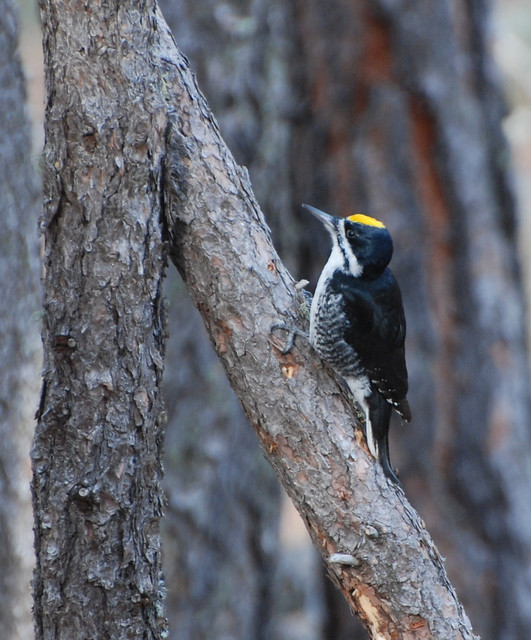

Appearance
As you may have guessed, the Black Backed Woodpecker has an entirely black back. The tail is also black, but the outer edges are white.
Its wings and sides have a black and white bar pattern, while its underparts are entirely white.
The other defining characteristics are the white streak on each cheek and the yellow bar on the crown. Both genders have the white streak, but only males have the yellow bar.
Location
This bird is also known as the Arctic Three Toed Woodpecker, so it’s distributed chiefly throughout Canada, where it’s cold.
However, it’s also found in the upper regions of the USA, such as the northern edges of Michigan.
Additionally, this woodpecker species isn’t migratory, so you can look for it in northern Michigan all year. The only problem is that it’s pretty uncommon.
You can usually find one in boreal coniferous forests, especially in areas with many newly burnt or dead trees.
Diet
Black Backed Woodpeckers primarily eat insects, specifically the larvae of wood-boring beetles that they excavate out of trees.
This excavation is evident in burnt forests where black trunks have orange spots. This is a sign of them peeling off the charred bark while finding insects, revealing the orange layer underneath.
Fun Fact: Black Backed Woodpeckers don’t use the same nest – they will continuously excavate a new one. Because of this, their old nests are occupied by other bird species.
2. Downy Woodpecker (Dryobates pubescens)
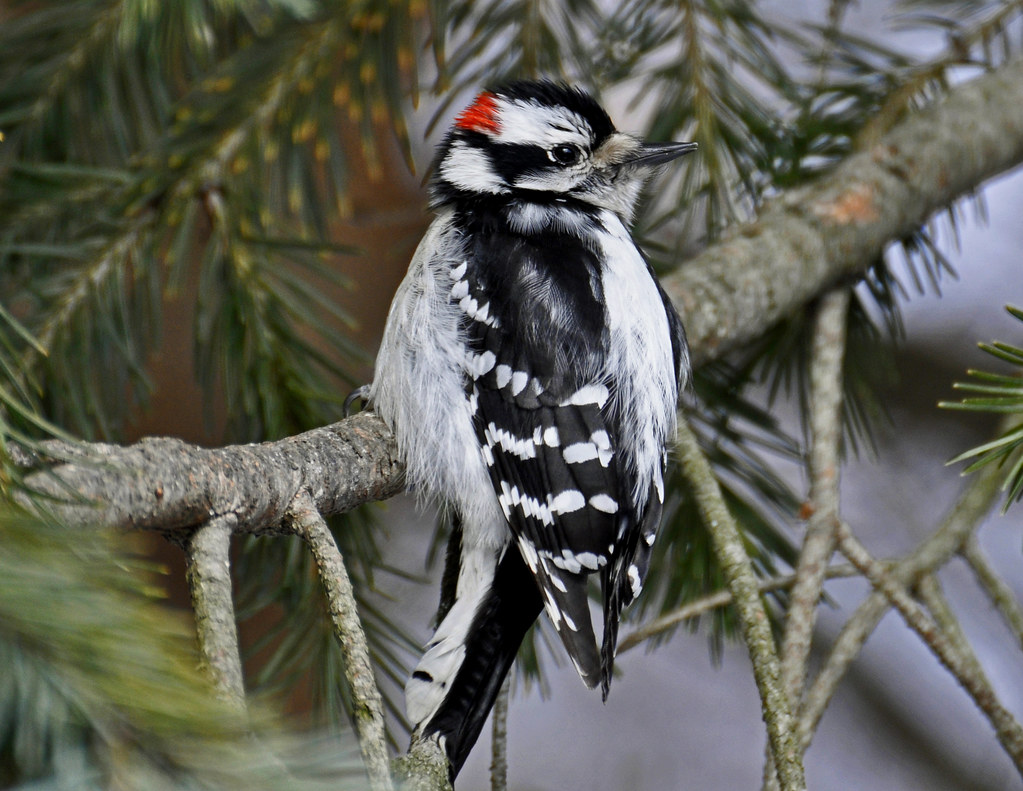
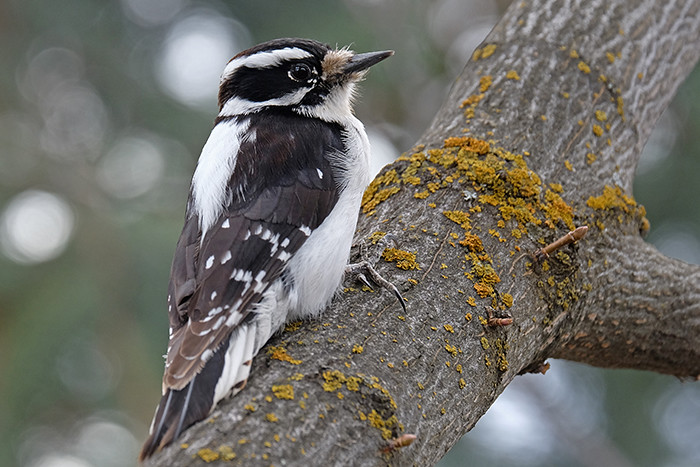
Appearance
The Downy Woodpecker has a white back and underparts, while its tail and nape are black. Its wings are also black, except there are white spots.
Both genders have black and white stripes on the face, but only the male has a red spot on the crown.
Location
Downy Woodpeckers are widespread throughout North America. They are also non-migratory, so you can find them anytime throughout Michigan.
They are so common that you would most likely find a Downy Woodpecker first out of all the woodpeckers in Michigan!
They prefer living in forested areas with dead trees or dead branches on a live tree. However, they readily enter towns, city parks, and bird feeders for food.
Diet
Downy Woodpeckers feed primarily on insects, especially ants and beetles.
However, when they visit a bird feeder, they also eat seeds, nuts, and suet. Sometimes, they are even seen drinking from a hummingbird feeder.
When they visit backyards, they may also be accompanied by other species, such as the Tufted Titmouse. Bonus birds!
Fun Fact: The Downy Woodpecker is the smallest woodpecker species in North America. Due to its size, it can access food and shelter that larger woodpeckers can’t.
3. Hairy Woodpecker (Leuconotopicus villosus)
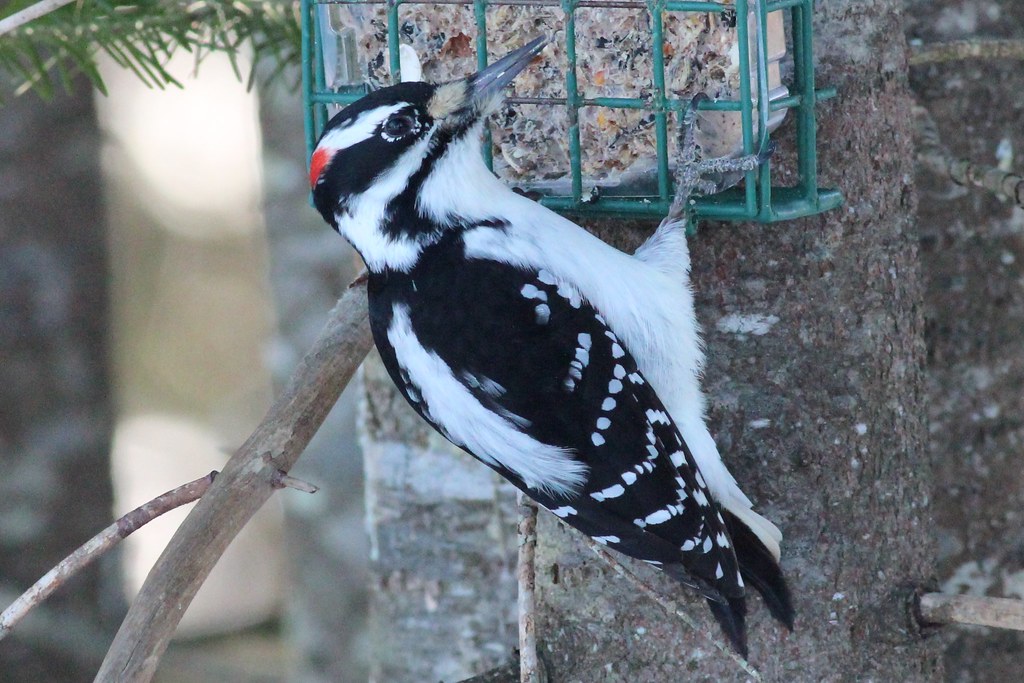
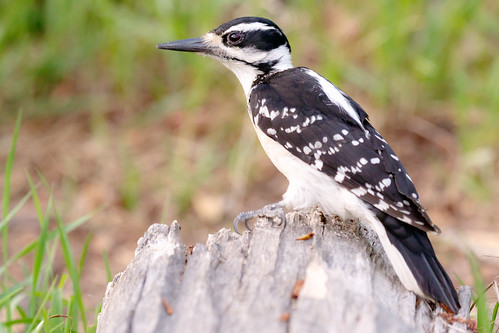
Appearance
The Hairy Woodpecker looks almost identical to the Downy Woodpecker – white back and underparts, black nape and tail, and black wings with white spots.
Both genders also have a black-and-white striped face, but only the males have a red spot on the crown.
You can differentiate these two species through size, as the Hairy Woodpecker is larger. However, this may be difficult at a distance or if you don’t see them side-by-side.
Location
Hairy Woodpeckers have an extensive range throughout North America. Though they are less common, they often occur with Downy Woodpeckers.
It’s possible that you saw them both and assumed they were the same birds!
Hairy Woodpeckers are also non-migratory, so you can find them in Michigan year-round. Extreme colds may drive them further south, but this doesn’t happen annually.
They are found in many habitats with large trees, as Hairy Woodpeckers are pretty adaptable. Plus, they are frequent visitors of backyard feeders.
Diet
A Hairy Woodpecker’s diet consists mainly of insects, such as beetles, ants, and caterpillars. However, they may also eat seeds, berries, and nuts.
This bird will most likely eat from a suet feeder in a backyard, although black oil sunflower seeds are still a good choice.
Fun Fact: Invasive species, such as the European Starling and the House Sparrow, tend to kick Hairy Woodpeckers out of their nest.
4. Northern Flicker (Colaptes auratus)
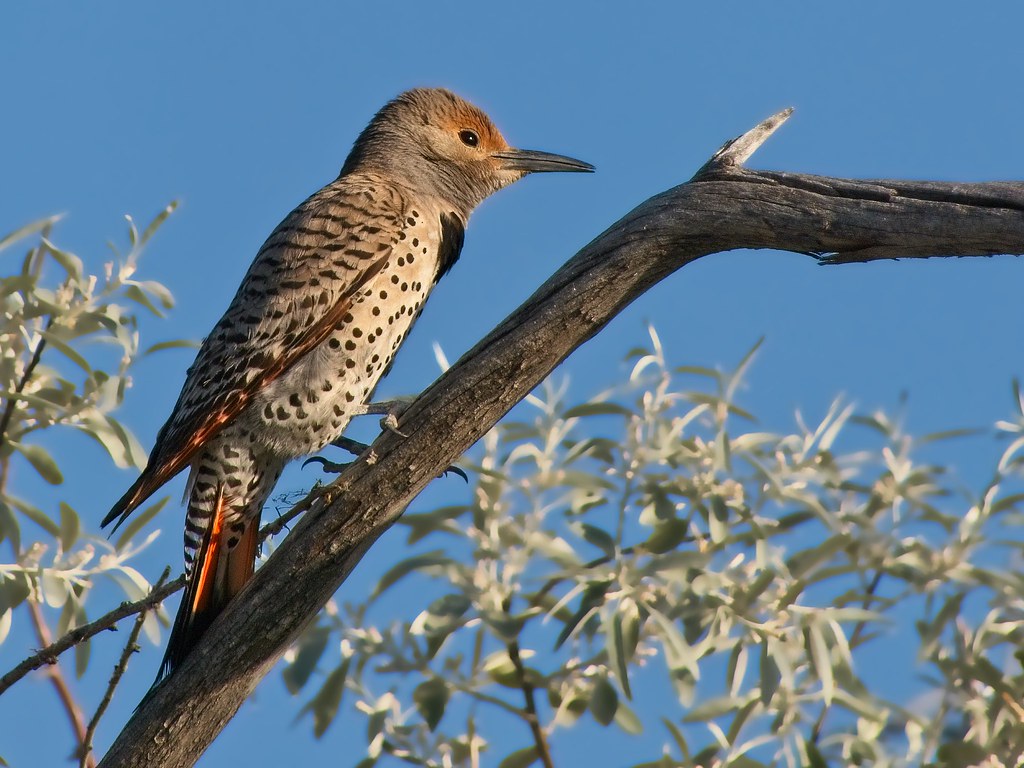

Appearance
Also known as the Common Flicker, the Northern Flicker is quite a unique species compared to the other woodpeckers of Michigan.
Its upperparts are brown with black bars, whereas the rump is white and the tail is black.
Meanwhile, the underparts are pale brown with black spots, and the breast has a black crescent.
Finally, the face is gray-brown with a black streak over the mouth and a red stripe on the nape.
To make it more complicated, the Northern Flicker is divided into two races, which depend on the color of the feathers on the backside of the wings and tail.
Location
Northern Flickers are permanent residents of the USA. Still, they may only spend summer in the northernmost states and winter in the southernmost states.
For example, they can only be seen during summer in northern Michigan. In contrast, they are year-round residents in the state’s southern half.
They are found in most habitats with trees, particularly in open woodlots, forest edges, and semi-open country.
Diet
Compared to other woodpeckers, Northern Flickers do not excavate trees for food. Instead, they find food on the ground, such as ants.
They also eat other insects, berries, fruits, and even sunflower seeds and thistle from feeders.
Fun Fact: Northern Flickers use a drumming technique for courtship. They tend to practice on the metal pipes of fireplaces, which can be inconvenient for humans.
5. Pileated Woodpecker (Dryocopus pileatus)


Appearance
We’re now onto the Pileated Woodpecker, the largest woodpecker in North America!
It has a primarily black body, except for the upper half of its wings, which is white. This white part is only visible in flight.
The face has black and white streaks, paired with a prominent red crest that’s just as recognizable as the crest of the Northern Cardinal!
There are minimal differences between both genders, as only the male has a red streak on the cheek.
Location
Pileated Woodpeckers are year-round residents in the eastern USA, though they are also present in some western states.
In Michigan, they are found throughout the state but not as common in its southern regions.
They are usually found in various mature forests with many dead trees. If they are left unbothered, you may also find them at woodlots and parks around cities.
Diet
Most of a Pileated Woodpecker’s diet consists of carpenter ants, and the rest are other insects, fruits, and berries.
You can tell this Michigan bird’s presence if you see deep, rectangular excavations in rotten wood. These excavations can be so deep that small trees break in half!
You may also attract one with a suet feeder. However, this is pretty rare as Pileated Woodpeckers are shy around humans. Your odds may increase if you have dead trees in your backyard.
Fun Fact: Pileated Woodpeckers peck the bark around their nest’s entrance to make the sap run down the tree. This prevents some predators from invading their space.
6. Red Bellied Woodpecker (Melanerpes carolinus)


Appearance
From above, the Red Bellied Woodpecker has a black-and-white striped back, black wings and tail with white bars, and a white rump and face.
From below, it has pale-gray underparts with a faint red tint on the belly, hence the name.
Compared to other woodpeckers in Michigan, it doesn’t have a black-and-white striped face. Instead, its face is pale-gray with a red crown and nape. However, the female doesn’t have the red crown.
Location
Red Bellied Woodpeckers are found year-round in the eastern half of the USA.
Hence, they are prominent in Michigan but not as common in the northern edges of the state.
They are often found in woods, especially in deciduous forests close to a river or swamp. However, they may visit your bird feeder if you live in a wooded area.
Diet
Although omnivorous, Red Bellied Woodpeckers lean more into plant material, where over 50% of their diet consists of nuts, fruits, and seeds.
If you want to attract one to your backyard, we recommend putting suet and black oil sunflower seeds in your feeders.
Fun Fact: Red Bellied Woodpeckers are attracted to resonating sounds. Males will often tap on the metal parts of houses and cars to attract mates.
7. Red Headed Woodpecker (Melanerpes erythrocephalus)

Appearance
Among the Michigan woodpeckers, you’ll probably recognize this one immediately!
For starters, the Red Headed Woodpecker has black upperparts and tail, while the rump and underparts are white. Plus, the wings are black, with a large white spot at the bottom.
However, when you look at the head, you’ll notice how the face, throat, and upper breast are entirely red.
Location
Like the previous Michigan bird in this list, Red Headed Woodpeckers are found in the eastern USA.
However, they only visit Michigan in the summer, though some may stay year-round in southern Michigan.
They are often seen in groups around spacious forests, woodlots, and even fallen trees in swamps.
Diet
Red Headed Woodpeckers are one of the most omnivorous woodpeckers, where they eat various insects, seeds, and even small rodents.
Though they aren’t familiar visitors of bird feeders, you may try your chances by providing suet.
Fun Fact: Instead of excavating trees for insects, Red Headed Woodpeckers hunt bugs mid-air. This is a pretty unusual trait for a woodpecker.
8. Yellow Bellied Sapsucker (Sphyrapicus varius)
Appearance
The last among the woodpeckers in MI is the Yellow Bellied Sapsucker.
It shares many characteristics that most woodpeckers have – black-and-white barred upperparts, wings, and tail, black-and-white striped face with a red crown, you already know how it goes.
As ” yellow bellied ” suggests, what sets this bird apart is its yellow-washed white underparts.
Both genders share all of the mentioned characteristics, but only the males have a red chin.
Location
Yellow Bellied Sapsuckers are usually found on the easter half of North and South America, although specific locations vary with seasons.
For example, they are only present throughout Michigan during summertime.
You may typically find them in woodlands, especially where deciduous and coniferous trees are abundant.
Diet
As you may have guessed, the sapsucker’s diet primarily consists of tree sap, compared to other species which feast on insects.
Although insects may still be consumed, Yellow Bellied Sapsuckers prioritize taking in as much sap from trees.
This means that you wouldn’t typically find one near a backyard feeder, but you may still try your luck with suet.
Fun Fact: Yellow Bellied Sapsuckers are considered “keystone species” as they significantly affect the ecosystem. Specifically, the sap wells they make are beneficial for other animals!
Watch This!
Frequently Asked Questions
What kind of woodpeckers live in Michigan?
As a recap, here are the woodpeckers that you may find in Michigan all year:
- Black Backed Woodpeckers (northern Michigan)
- Downy Woodpeckers
- Hairy Woodpeckers
- Northern Flickers (southern Michigan)
- Pileated Woodpeckers
- Red Bellied Woodpeckers
Do woodpeckers migrate in Michigan?
Out of the eight Michigan woodpecker species, only two are migratory.
Specifically, Red Headed Woodpeckers and Yellow Bellied Sapsuckers are only in Michigan during summer.
Northern Flickers are a special case, where they are only in north Michigan during summer but year-round in the south.
Is it illegal to shoot a woodpecker in Michigan?
Yes! All woodpeckers are protected under the Federal Migratory Bird Treaty Act, so it’s illegal to shoot them unless you have a permit.
If you’re having a woodpecker problem on your property, it’s best to contact authorities instead.
Conclusion
Well, that’s about it for the types of woodpeckers in Michigan.
If you want to look for them all, we recommend exploring the state parks and forests around the state. You may try setting up bird feeders, but it may take you a lot of luck to find some of the elusive woodpeckers of Michigan.
That’s not a total waste, however, since you can also attract other backyard birds, such as the American Robin, House Finch, American Crow, Blue Jay, and more!

